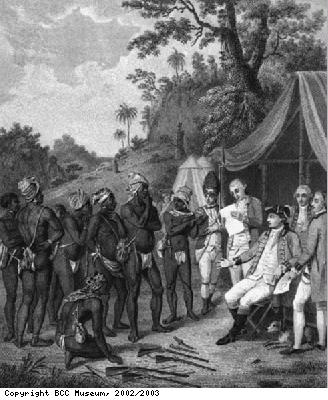How Slavery Developed
Rebellion
Enslaved Africans fought against their enslavement in many ways. They tried to keep their African heritage alive in words, music, names and beliefs or customs. Some started rebellions, some ran away. Many runaways were caught and punishments were severe. Some, however, remained free.
There were lesser ways that the enslaved Africans could cause annoyance, disruption and show their dissatisfaction. There were many incidents of avoiding work, theft, arson and sabotage of machinery. African women were skilled users of herbal medicines and plantation owners lived in fear that they would secretly be poisoned.
In Jamaica in the Caribbean, many slaves ran away from the plantations and built homes in the mountains. They resisted capture for over a hundred years. Eventually the British (who governed the island) made a pact with them. They were given land and their freedom was officially recognised. As part of this pact the Maroons, as they were known, agreed to recapture runaway slaves and hand them in to the authorities.
On the Caribbean island of Nevis, Edward Huggins, a brutal plantation owner, was five times nearly killed by his slaves. The slaves later rebelled and were most cruelly punished and one subsequently died. Huggins was eventually brought to trial. The jury was made up of white plantation owners and ‘found’ Huggins not guilty of cruelty. The trial was reported in England and caused uproar, encouraging many people at last to support the campaign to end slavery.

 Bristol’s merchants
Bristol’s merchants Examples of cargoes
Examples of cargoes Abolition
Abolition Rebellion
Rebellion Sugar Plantations
Sugar Plantations African heritage
African heritage The voyage
The voyage ‘Buying’ the slaves
‘Buying’ the slaves Bristol ships go to Africa
Bristol ships go to Africa Goods to trade
Goods to trade

